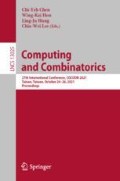Abstract
It is well known that the copy language \(L = \{ww \mid w \in \varSigma ^*\}\) is not context-free despite its simplicity. We study pseudo-copy languages that are defined to be sets of catenations of two similar strings, and prove non-context-freeness of these languages. We consider the Hamming distance and the edit-distance for the error measure of the two similar strings in pseudo-copy languages. When the error has an upper bound or a fixed value, we show that the pseudo-copy languages are not context-free. Similarly, if the error has a lower bound of at least four, then such languages are not context-free, either. Finally, we prove that all these pseudo-copy languages are context-sensitive.
H. Cheon and J. Hahn—The first two authors contributed equally to this work.
Access this chapter
Tax calculation will be finalised at checkout
Purchases are for personal use only
Notes
- 1.
We only consider even-length strings for the Hamming distance between two halves.
- 2.
References
Anderson, T., Rampersad, N., Santean, N., Shallit, J.: Finite automata, palindromes, powers, and patterns. In: Proceedings of the 2nd International Conference on Language and Automata Theory and Applications, pp. 52–63 (2008)
Apostolico, A., Preparata, F.: Optimal off-line detection of repetitions in a string. Theor. Comput. Sci. 22(3), 297–315 (1983)
Bordihn, H., Mitrana, V., Păun, A., Păun, M.: Hairpin completions and reductions: semilinearity properties. Nat. Comput. 20(2), 193–203 (2020). https://doi.org/10.1007/s11047-020-09797-0
Bordihn, H., Shallit, J.: Personal communication
Crochemore, M.: Recherche linéaire d’un carré dans un mot. Comptes rendus de l’Académie des sciences. Série I, Mathématique 296(18), 781–784 (1983)
Ehrenfeucht, A., Rozenberg, G.: On the separating power of EOL systems. RAIRO Theor. Inform. Appl. 17(1), 13–22 (1983)
Gusfield, D.: Algorithms on Strings, Trees, and Sequences: Computer Science and Computational Biology. Cambridge University Press, USA (1997)
Hamming, R.W.: Error detecting and error correcting codes. Bell Syst. Tech. J. 29(2), 147–160 (1950)
Hopcroft, J.E., Motwani, R., Ullman, J.D.: Introduction to Automata Theory, Languages, and Computation, 3rd edn. Pearson Education Inc, Boston, MA, USA (2006)
Kolpakov, R., Kucherov, G.: Finding approximate repetitions under Hamming distance. Theor. Comput. Sci. 303(1), 135–156 (2003)
Kutrib, M., Malcher, A., Wendlandt, M.: Queue automata: foundations and developments. In: Adamatzky, A. (ed.) Reversibility and Universality. ECC, vol. 30, pp. 385–431. Springer, Cham (2018). https://doi.org/10.1007/978-3-319-73216-9_19
Landau, G.M., Schmidt, J.P., Sokol, D.: An algorithm for approximate tandem repeats. J. Comput. Biol. 8(1), 1–18 (2001)
Levenshtein, V.I.: Binary codes capable of correcting deletions, insertions, and reversals. Sov. Phys. Doklady 10(8), 707–710 (1966)
Lischke, G.: Squares of regular languages. Math. Log. Q. 51(3), 299–304 (2005)
Lothaire, M.: Combinatorics on Words, 2nd ed. Cambridge University Press, Cambridge (1997)
Main, M.G., Lorentz, R.J.: An \({O}(n \log n)\) algorithm for finding all repetitions in a string. J. Algorithms 5(3), 422–432 (1984)
Ogden, W.F., Ross, R.J., Winklmann, K.: An “interchange lemma’’ for context-free languages. SIAM J. Comput. 14(2), 410–415 (1985)
Ross, R.J., Winklmann, K.: Repetitive strings are not context-free. RAIRO Theor. Inform. Appl. 16(3), 191–199 (1982)
Sipser, M.: Introduction to the Theory of Computation, 3rd edn. Cengage Learning, Boston, MA, USA (2013)
Stoye, J., Gusfield, D.: Simple and flexible detection of contiguous repeats using a suffix tree. Theor. Comput. Sci. 270(1), 843–856 (2002)
Vollmar, R.: Über einen automaten mit pufferspeicherung. Computing 5(1), 57–70 (1970)
Acknowledgments
We wish to thank the referees for valuable suggestions that improve the presentation of the paper.
This research was supported by the NRF grant funded by MIST (NRF-2020R1A4A3079947, NRF-2018R1D1A1A09084107).
Author information
Authors and Affiliations
Corresponding author
Editor information
Editors and Affiliations
Rights and permissions
Copyright information
© 2021 Springer Nature Switzerland AG
About this paper
Cite this paper
Cheon, H., Hahn, J., Han, YS., Ko, SK. (2021). Most Pseudo-copy Languages Are Not Context-Free. In: Chen, CY., Hon, WK., Hung, LJ., Lee, CW. (eds) Computing and Combinatorics. COCOON 2021. Lecture Notes in Computer Science(), vol 13025. Springer, Cham. https://doi.org/10.1007/978-3-030-89543-3_16
Download citation
DOI: https://doi.org/10.1007/978-3-030-89543-3_16
Published:
Publisher Name: Springer, Cham
Print ISBN: 978-3-030-89542-6
Online ISBN: 978-3-030-89543-3
eBook Packages: Computer ScienceComputer Science (R0)

